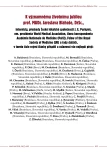Current options and principles of pathomorphology-based tumour diagnostics
Authors:
C. Povýšil
Authors‘ workplace:
Ústav patologie 1. lékařské fakulty UK a VFN Praha, přednosta prof. MUDr. Ctibor Povýšil, DrSc.
Published in:
Vnitř Lék 2010; 56(7): 709-714
Category:
80th Birthday - Jaroslava Blahoše, MD, DrSc.
Overview
Modern pathomorphology tumour diagnostics involve comprehensive cytology cell examination and, importantly, tissue biopsy examination using the most up-to-date assessment techniques. To correctly classify a tumour process, it is essential not only to define its histological typology and identify its biological character but, at the same time, using immunohistochemistry and diagnostic molecular pathology, to evaluate prognostic and predictive indicators. As regards the prognostic indicators, it is mainly grading and staging as part of the TNM system, the sentinel lymph node assessment, if it is assessed, and other nodes extracted in this context. Histological specimens of invasive carcinomas and skin melanomas are assessed with respect to the depth of the invasion. Endocrine oestrogen and progesterone receptors are assessed in endocrine-dependent breast carcinomas. Predictive pathology uses biomarkers; biomarkers confirm the presence of target molecules following their reaction with the administered small molecule-like drugs, usually protein kinases or antibodies. HER2 gene amplification is estimated using the FISH method and predicts effectiveness of breast cancer therapies. In patients with a colon carcinoma, HER1 oncogene is identified immunohistochemically and the presence of a mutated K-ras is subsequently tested using the RT-PCR technique. CD 117 (c-kit) expression is determined in gastrointestinal stromal tumour and CD 20, 33 and 52 in malignant lymphomas and leukaemias. The most difficult task for a pathologist is defining the primary focus of the tumour in cases where only a fraction of a metastasis is available for examination. Nevertheless, at present, it is feasible to track the tumour differentiation down and, using an antibody battery, particularly against specific cytokeratines and vimentine and including organ-specific markers, to identify the primary source or at least to establish an assumption about the most likely organ affected by the tumour process.
Key words:
pathomorphology – tumours – diagnostics – modern methods
Sources
1. Povýšil C, Šteiner I et al. Speciální patologie. Praha: Galén a Karolinum 2007.
2. Rosai J. Surgical Patology. Edinburg: Mosby 2004.
3. Tavassoli F, Devilee P. Pathology and genetics of tumours of the breast and female genital Organs. WHO classification of tumours. Lyon: IARC Press 2003: 9–112.
4. Dvořáček J, Babjuk M et al. Onkourologie. Praha: Galén a Karolinum 2005.
5. van Krieken JH, Jung A, Kirchner T et al. KRAS mutation testing for predicting response to anti‑EGFR therapy for colorectal carcinoma: proposal for an European duality assurance program. Virchows Arch 2009; 454: 233–235.
6. Dabbs D. Diagnostic immunohistochemistry. Churchill Livingstone: Elsevier 2006.
7. Abrahámová J, Povýšil C, Dušek L et al. Nádory varlat. Praha: Grada 2008.
8. Miettinen M. Diagnostic soft tissue pathology. Churchill Livingstone: Elsevier 2003.
Labels
Diabetology Endocrinology Internal medicineArticle was published in
Internal Medicine

2010 Issue 7
Most read in this issue
- Laboratory diagnostics and endocrinology
- Parvovirus B19 infection – the cause of severe anaemia after renal transplantation
- The influence of testosterone on cardiovascular disease in men
- Chronic pancreatitis and the skeleton
